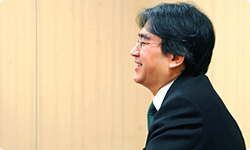5. A Wish for Everyone to Become Healthy
There aren’t many games out there that make you move about quite like Wii Fit. I’m sure that all of you discovered something new about your bodies while you were working on this project. Minegishi-san, you had an interest in balance before working on Wii Fit; what was it like for you?
Well, as an example of how interested in balance I was, I’d actually taken classes on natural body alignment, where the teacher would watch me sit down, stand up and even crawl on the ground for about an hour... (laughs)
You were a bit of a balance geek, weren’t you? (laughs)
Exactly! (laughs) In those classes, I learned that people tend to lean back when standing normally, so I tried to focus on pushing my centre of balance towards the front, and eventually I was sure that I’d managed to acquire good balance. However, with Wii Fit, you can actually see your centre of balance on-screen. So when I confidently stepped onto the Wii Balance Board, I was in for a real shock – my centre of balance was right in the back! (strained laugh) However, as I continued to play Wii Fit on a daily basis, I managed to bring my centre of balance to the centre of my body, which was quite a relief.
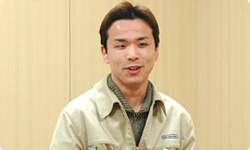
I wasn’t quite the balance geek that Minegishi-san was, but I had a feeling that my centre of balance was leaning towards the left. However, as I began to use the Wii Balance Board on a daily basis, I started becoming much more aware of my leftward lean. As a result, I started doing things like switching the hand that I usually carried my bag with. These lifestyle changes were completely new to me in the field of game development. I felt that this was the true essence of a game related to daily life. I hope that the people who play Wii Fit will experience these kinds of changes as well.
I was more worried about my weight than my balance. I thought it strange that even though I was moving around a lot every day, my weight didn’t seem to be going down.
It didn’t go up, did it? (laughs)
It did! (laughs) As we entered the busiest stage of the development process, the fact that I was gradually gaining weight instead of losing it was clearly graphed out for me to see. That, to me, was more evidence of the huge scope of Wii Fit.
They do say that stress makes you put on weight. By the way, did you ever compete to see who could lose the most weight?
They wanted to take some data samples, so Hosaka-san and I, as well as some other team members, decided to give it a go. There was a big TV in the development room, so everybody’s daily progress could be seen by anyone.
So everyone’s weight details were pretty much laid bare! (laughs) They told us, “It’ll only show the change in BMI, so don’t worry, no one will know your weight.” But whenever I suddenly lost weight because I’d been working hard on my diet, they’d think that something was wrong with the system. And, of course, by recalculating the results to check that they were correct, they’d discover my weight! (laughs)
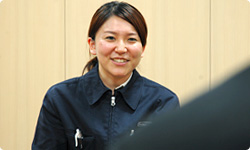
(laugh)
Still, there were good things about this process, too. There was a point where my weight dropped drastically. I thought this was strange, because I hadn’t been particularly trying hard to lose weight. But soon afterwards, I became ill. From that point on, the PLs (project leaders) would check on me to see if I was okay any time my weight dropped.
So not only were you able to monitor your own health, the others looked out for you as well. That’s a very heart-warming story.
During that time, I had this image of me playing Wii Fit in the living room at home and, for example my mum noticing that I was losing weight, getting worried and preparing a huge meal for me. I thought, wouldn’t that be nice? (laughs)
(laugh)
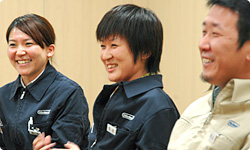
On the other hand, there was a time when Matsunaga-san, the chief director, kept gaining weight, and I was wondering why when I realised that an internal presentation was coming up.
(laugh)
It’s true! (laughs) I thought at the time that maybe stress was influencing his weight. But it turns out that some people gain weight and others lose weight when they’re stressed.
Oh, I know all about that. I’m the kind that gains weight!
(laugh)
At any rate, it’s quite something to be able to see everyone’s changes in weight together. It’s kind of like watching the news every day.
We would all line up in front of the monitor and analyse the results as a group, discussing things like what it was that we ate that caused us to gain weight.
I think families who play Wii Fit might end up having conversations like that as well. I think checking these results every day can be a fun motivational factor for playing Wii Fit consistently.
Finally, I’d like to ask you to leave a message for the customers about what you’d like them to look for in Wii Fit. In Minegishi’s case, that’ll be what he’d like the customers to listen for! (laughs)
As far as music goes, I’d recommend listening to the Step Basics music , which matches the step rhythm pretty well. This was bounced back and forth between Hosaka-san and the sound team for quite a while. Step Basics is a simple aerobic exercise, but it really does blend well with the music, and I think it’ll prove to be a lively, enjoyable experience. But rather than recommend a particular sound detail, I’d like to point out, as I mentioned earlier, that I designed all the music and sound effects in Wii Fit to cheer on and support people trying to improve their health and make Wii Fit a comfortable place to be. As such, I’d like to encourage everyone to stick with Wii Fit and keep up their training efforts.
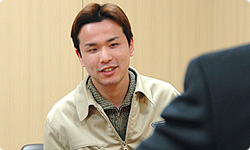
The trainers in this game are fully-voiced. This is something that EAD has rarely done, so I hope you enjoy this aspect. There’s one more thing I’d like to mention. Most yoga instruction materials are quite bland and lack feeling, don’t they? However, in Wii Fit, the trainers will keep an eye on your movements, so if you get off the Wii Balance Board in the middle of an exercise and slack off, the trainer will notice and tell you off or ask you to come back.
That’s really unusual, isn’t it? For a game to know that you’re slacking off? (laughs)
That kind of feature would be impossible on yoga DVDs and the like, but Wii Fit has all sorts of interactive tricks that could only be implemented because it’s a video game. Another thing is that the voices for the male and female trainers have been set up to give them individual personalities, which you might sometimes hear coming through their spoken dialogue. This makes the same exercise feel completely different depending on which trainer you have, so rather than just deciding, “Oh, I want the male trainer”, I hope you consider training with both. Just be careful not to train too hard and end up with sore muscles! (laughs) After all, you’ll initially be exercising muscles you don’t really use in day-to-day life.
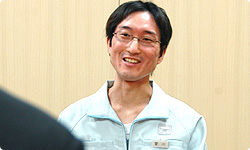
I’ve designed the Mii’s figure to change depending on the changes in your own weight. As you continue recording your weight, you’ll be able to watch the changes in your Mii’s figure at a sped-up rate, like watching a high-speed film of the growth of a plant. I hope you’ll weigh yourself every day so you can experience this feature for yourself. I believe this is the kind of game where you’ll keep making new discoveries as you continue playing. Your reward for your dedication, of course, is watching your Mii lose weight. (laughs)
Yes, but I’m not sure that users who keep gaining weight will want to watch their Mii characters gain weight at a rapid speed!
(laugh)
We’ve tried to avoid doing anything that would upset or rub anyone the wrong way when they’ve put on weight, so I think we should be okay in that regard. Still, we have put in features that will change your Mii’s figure to reflect your actual weight to prevent you from, for example, trying to alter your Mii characters to look slimmer. So I hope that this acts as a motivational factor for you to continue playing Wii Fit.
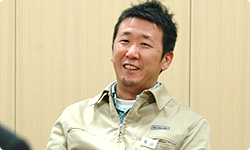
Rather than telling customers to try a certain feature of the game, I’d like for them to just try getting on the Wii Balance Board every day. Good health is something that you have to work on every day, and to that extent we’ve tried particularly hard to include features that will make you want to get on the Wii Balance Board every day. There’re a lot of things that only become available the more you play, such as unlockable features and new comments made by the Wii Balance Board character. Additionally, I think watching your progress being graphed out will be quite fun and could become an interesting topic of conversation for your family, so I’d like you to get on at least once a day.
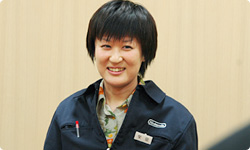
Wii Fit’s been designed so that anyone can easily get into it. We’ve made sure the instructions are clear and easy to understand, so I believe that everyone, even older players, will be able to enjoy Wii Fit. It’s easy to get into, but as you get more and more involved in your favourite exercises you’ll unravel the deeper elements of the game that will suck you in even more. So my hope is that you’ll stick with Wii Fit for a long time. We’ve also prepared a huge variety of exercises, so I’d like to encourage everyone to try them all and get fit.
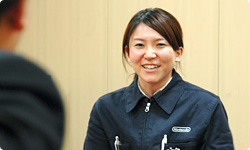
Wii Fit originally started out with Miyamoto-san’s idea that weighing yourself daily can be fun, so this really felt like a project that was started from scratch. These stories of fateful encounters, the birth of the Wii Balance Board, getting people who worked on Zelda onboard, and finally bringing the project to completion despite originally having had no idea where to even start, are what I consider to be the elements that really make product development interesting. I’d like to conclude this interview by conveying my hopes that, a year from now, customers all across Japan will be talking about their changes in weight and the reasons behind them, and grandparents and grandchildren, maybe even mothers and daughters will be enjoying Hula Hoop™ and the other Wii Fit features together. Everyone, thank you very much for your hard work on this project.
